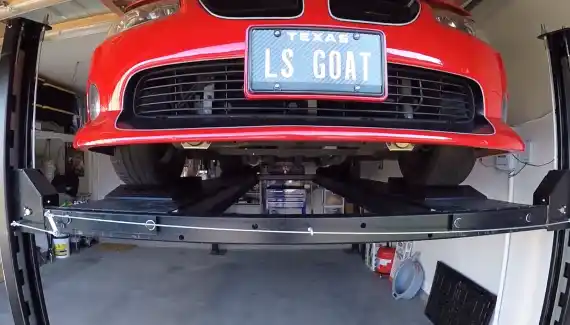Last Updated on May 29, 2023
If you’re considering upgrading your garage with a car lift, one thing to consider is the height. You’ll want to ensure enough clearance for the lift and any vehicles you plan to lift. So check out how tall the garage needs to be for the lift first.
Achieving that extra garage space is surprisingly easier than you’d think. Assuming your ceilings are at least 11 to 12 feet high. But even if they’re not, there’s no need to worry. Just optimize the area, and voila. You’ll be able to create a spacious, fully-functioning, and safe garage space with a car lift.
When building your garage, there are many important factors to consider. Ensure the car fits snugly beneath it with sensible extra clearance and measuring lift specifications. Having all bases covered means being safe and secure when storing beloved cars.
This post explains everything you need to know about installing a car lift and choosing the right ceiling height for maximum functionality.
How Tall Does Garage Need To Be For Lift: Calculation

Figuring out how tall your garage should be for a car lift can be a challenging process, but there are several steps you can take to ensure the lift is installed correctly:
Step 01: Measuring the Height of the Car
When measuring the height of a car that will be lifted, it is important to consider both the clearance above and below the car. To accurately measure the height, begin by using a tape measure to measure from the ground up to the tallest point on top of the car.
And you should also take into account any accessories, such as spoilers or roof racks, that may add extra height. Then, find the lowest point on the bottom of the car.
This will give you an accurate measurement of how much clearance your lift needs above and below your vehicle when used.
Step 02: Check the Specifications of the Lift
Once you have determined the clearance required above and below your vehicle, you can now check the specifications of your lift model to ensure it satisfies these requirements.
You can find this information either in the product manual or on websites. The specifications will include details such as the maximum rated lift height and maximum capacity weight limit, which should be considered when choosing a lift.
Also, some lifts may have additional features, such as adjustable height arms, so make sure to pay close attention to all details listed to make an informed decision when selecting your lift model.
And it is essential to remember that some lifts may require additional space depending on where they will be installed and what type of work is being done with them.
For example, plan on performing brake service on a vehicle. There must be adequate room for technicians to safely access all components without risking injury or damaging materials. Here is some garage lift ideas:
No 1: 2 Post Lift Car Auto Truck Hoist
Featuring durable steel construction, this lift can lift up to 6,000 lbs., making it ideal for cars, light trucks, small buses, and other larger vehicles. It includes adjustable arm restraints for secure lifting, plus convenient drop-in mounting tabs that easily fit most frames.
The posts have a low profile design that allows for easy access in confined spaces while still providing plenty of height clearance to get underneath most vehicles quickly. This dependable lift also features an overload safety valve, so you never exceed your weight limit.
No 2: Two Post Floor Plate Auto Lift Car
Equipped with two hydraulic cylinders and heavy-duty steel construction, it can safely transport up to 4,000 lbs. This lift offers superior stability with adjustable arm restraints and comes equipped with drop-in mounting plates that provide quick installation without much hassle.
With its extra-long arms and single-point lock release system, this lift provides easier access when reaching under even the longest cars or trucks. It is perfect for all car service operations.
No 3: Extended-Length Portable Car Lift

This robust mobile unit has an impressive 6” lifting range that can accommodate up to 8,000 lbs., allowing you to raise multiple vehicles at once without worrying about stability or balance issues.
Constructed from thick steel plates, this rugged lift offers superior strength as well as superior portability; featuring easy folding capabilities and lightweight construction so you can easily move it around the shop or job site with ease.
Plus, due to its telescopic design and built-in locking mechanisms, you can trust your load will remain safely suspended at any height until it’s ready to be lowered again.
No 4: 4-Post Portable Storage Service Car Auto Lift
Featuring a unique vertical design that requires minimal space requirements, this heavy-duty lift offers maximum working flexibility with three 2 ½” moving arms that can be adjusted depending on vehicle size or desired angle of access.
The oversized platform provides ample support while handling even the biggest jobs. It can hold up to 8,000 pounds (maximum rated capacity). Its sturdy four-post design offers increased stability during transportation or storage operations.
Step 03: Consider the Height of the Lift Platform
Figuring out lift platform height involves understanding the exact size of the lift itself. This information can usually be found in the product manual or the manufacturer’s website.
A lift platform’s height will need to be considered when calculating how much height is needed for your garage.
It’s important to remember that if you are installing a car lift with a sloped surface, then you may need more clearance than what is given in the product manual. This is because a sloped surface lifts cars at an angle and requires more height for operation.
Step 04: Add In Extra Clearance
Once you have established the garage’s minimum height based on the lift size, you will also need to factor in any additional clearance required to operate safely and effectively.
This might include additional space around hydraulic components or room for cars to be lifted and lowered without making contact with any part of their bodywork or other surrounding objects.
When deciding how much extra clearance to add, it is better to add more than less. This is because if you do not have enough clearance, you might damage the vehicle or something else while lifting or lowering it.
Step 05: Calculate the Minimum Height Requirement
The last step in determining how tall your garage needs to be for a car lift is to add up all of these measurements together: the car’s height, the lift platform, and any necessary extra clearance.
Once you have done this, you will have your minimum height requirement for your garage so that you can install and operate your car lift safely and effectively.
Remember that it’s always better to go slightly over this measurement than under it, as this ensures there won’t be any issues down the line when using it due to insufficient headroom.
Do Garage Ceilings Have to be High for a Lift?

The minimum ceiling height for a two-post lift is 11-12 feet, while four-post lifts require a higher ceiling. If you have large vehicles or activities that require a lot of space, the recommended garage ceiling height is 10 feet with an 8′ garage door.
And most residential garages (attached) are 9 feet or higher due to the even top plates and the drop from the living area floor joists and 8′ ceilings.
No matter what type of lift you’re planning on installing in your garage, it’s important to make sure that your ceiling meets the necessary requirements for installation.
What Is the Lowest Legal Ceiling Height For a Garage?
When it comes to the garage ceiling height, it depends on the type of garage door you have. For a standard 7-foot garage door, the minimum ceiling height required is 8 feet. This includes the 14 inches of headroom necessary for the track installation.
If you have a larger vehicle or hobbies that require more space, then 10 feet is recommended as the ideal ceiling height for your garage.
What Size Garage Do I Need For a 2 Post Lift?
If you’re looking to install a 2-post lift in your garage, you’ll need a minimum of 12 feet of clearance. This is because many lifts come with an overhead cross beam, and additional clearance is necessary for the lift to work properly.
When positioning your two post lifts, there are many factors that will determine the best place to mount it. If you have unlimited garage space, then there is more flexibility in where it can be placed.
But, if space is limited, make sure to take into account the height of the vehicle and any other obstructions that may be present when deciding on a location.
How Tall Should a Garage Ceiling Be For a 4 Post Lift?
When installing a 4 post lift in your garage, the ceiling height is an important factor. Generally speaking, you will need a minimum of 11-12 feet of clearance for a two-post lift and more for a four-post lift. This is because four-post lifts require more space than two-post lifts.
It’s also important to consider the grade of your floor slab when determining the ideal garage ceiling height. For example, if you have a 9 foot tall garage door, plus 16 inches of headroom needed for the track installation, you would need a minimum ceiling of 10 feet 4 inches.
Are There Any Alternatives to a 2 or 4-Post Lift if Your Garage Ceiling is Too Low?
Depending on the height of your garage ceiling, there are a few alternatives to using a 4-post lift that you can consider.
01. Scissor Lift
One possibility is a scissors lift. These lifts consist of two large metal arms connected with hinges in the middle, allowing the arms to fold in on each other and save space when not in use. The arms have attached platforms and hydraulic cylinders that raise and lower the platforms.
These lifts are great for shorter ceilings because they don’t need as much headroom as traditional 4-post lifts. They also feature adjustable arm lengths, so you can adjust them depending on how much space you have available in your garage.
02. Inground Lift
A third option is an inground lift. This lift requires more installation work than other types but has the advantage of taking up much less space in your garage because the entire platform is below ground level when not in use.
This makes it ideal for garages with limited space since it won’t take up any room when unused. The main disadvantage of this type of lift is that it requires more installation work and is usually more expensive than its counterparts due to the complexity of installing it correctly and safely underground.
03. Air Jacks
Some people opt for air jacks instead of traditional vehicle lifts if their ceiling height isn’t sufficient to accommodate traditional models.
Air jacks are industrial-grade jack stands that use compressed air from an external source to support a vehicle’s weight by lifting it off the ground several inches at a time with each inflation cycle until it reaches its desired height.
While these allow you to get underneath your car for maintenance without needing extra headroom, they don’t offer as much stability as conventional lifts. They tend to be far more expensive due to their complex engineering requirements.
How To Ensure Your Garage Can Safely Accommodate A Car Lift?

Having enough space in your garage is essential if you plan on installing a car lift. Knowing the necessary measurements and clearance height will help ensure that your garage can safely and easily accommodate the lift.
While each type of car lift requires different measurements, it’s essential to check the specifications of the lift before making any decisions. And you should always add extra clearance for overhead items like lights or shelves installed above or near the lift platform.
Finally, legal minimum ceiling heights are required for any residential garage, so always check local codes before making any decisions. With these tips in mind, you should know just how tall your garage needs to be for a car lift.
